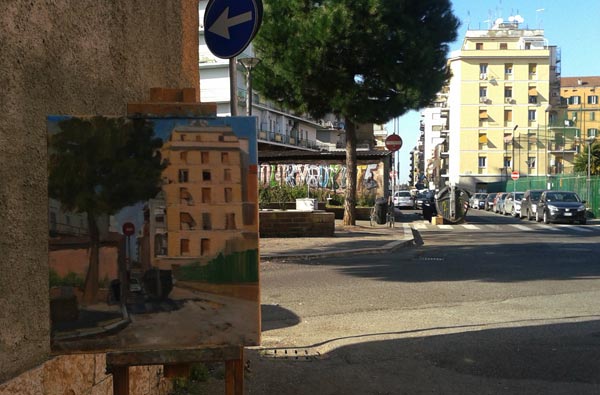Kelly Medford lives in a working-class neighborhood in Rome, Italy, that is rapidly changing. That’s appropriate for a plein air painter, because so is the light.

“The Morning Market, Pigneto,” by Kelly Medford, 2013, oil on board, 9 x 12 in.
And ironically, the warm light in Medford’s paintings is a dependable constant in her work from Rome. “When I moved here from Florence, what I noticed is that the light in Rome is so dramatically different,” says Medford. “It’s really warm, almost a rosy pink. When I moved here I had to keep buying so many different cadmiums because I couldn’t find the strength I needed to depict it. I made a conscious choice to exaggerate the warmth here. Now I really see it that way — that is really how I see Rome, and how I paint Rome.”

“First Thing Saturday Morning, Via del Pigneto,” by Kelly Medford, 2014, oil on linen, 15 3/4 x 11 3/4 in.

The scene depicted in “First Thing Saturday Morning, Via del Pigneto”
Her neighborhood in the Pigneto area is “in transition,” with age groups and socioeconomic classes shifting places, and changing the cityscape in the process. One could call it gentrification, but the way Medford describes it, the change may be more drastic than that. “This neighborhood has a long history of knocking things down and putting in ad hoc gardens,” she points out. “Shacks pop up with only one real wall. And now there are high-rises going up next to old buildings; it’s all a mix. Since more rich people are moving in, it will get nicer, but with more straight lines.” Alongside this are young immigrants and young families and hipsters taking abandoned buildings and turning them into something useful and wanted by the community, like a bike shop.

“The Homemade Bike Cart, ExSnia,” by Kelly Medford, 2014, oil on linen panel, 10 x 8 in.

The scene depicted in ” The Homemade Bike Cart, ExSnia.”
“A lot of these buildings will disappear because they are illegal,” Medford says matter-of-factly. “They are not built to code, and there are sprawling, pop-up gardens. I think the older places are probably going to disappear, so I am interested in capturing some of those old places.”
But it would be wrong to assume Medford is out to document the changes or try to preserve the area. She cares about the changes in her ‘hood, but she cares even more about how the light hits a favorite tree, or how a lemon-yellow building turns a warmer yellow in the Roman light. “I see reflected light everywhere,” she says. “Sometimes I don’t put enough contrast in because I see so much reflected, warm light. I make lots of bad paintings. The one of the tree by the Via del Pigneto I painted eight times.” Additionally, she feels free to add or remove cars or otherwise alter the scene as it suits her interpretation. “The more I practice, the more I think composing is the most important thing,” says the artist. “When I realize after an hour a painting is not going to work, I get out my sketchbook and draw it out, and try to figure out why it didn’t work. I’ll do value sketches, and try different compositions, and then come back and try painting it again, noting when the light is good.”

“The Old Trash Collector,” by Kelly Medford, 2014, oil on linen panel, 8 x 6 in.

The scene depicted in ” The Old Trash Collector”
Medford, an American, found her way to Italy when her teacher in the United States led a workshop in Tuscany. She attended it and liked the country, and her teacher recommended that she study at the Florence Academy. She learned a lot in her year at the academy, but at some point she realized she was in Italy, a beautiful country, but she was working in a studio with blackout drapes. “I started taking my easel outside and eating a lot of good food and seeing everything,” says Medford. “That’s how I got here and that’s why I stay here. It really suits me.” As does her neighborhood, where life is changing and great spots to paint are found with an easy bike ride through the warm Rome light.




